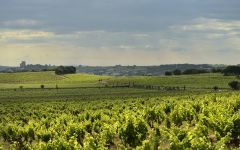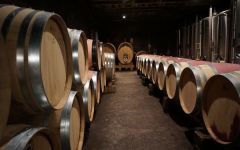Domaine de la Solitude Chateauneuf-du-Pape Cuvee Barberini 2001
-
Robert
Parker -
Wine
Spectator



Product Details
Your Rating
Somm Note
Winemaker Notes
Professional Ratings
-
Robert Parker's Wine Advocate
The outstanding 2001 Chateauneuf du Pape Cuvee Barberini (a blend of 40% Grenache, 40% Syrah, and 20% Mourvedre aged 24 months in 40% small barrels and 60% neutral wood foudres) boasts an inky/ruby/purple color in addition to a big, sweet nose of creme de cassis, melted licorice, graphite, smoke, and truffles. Full-bodied, lush, and expansively flavored, with tremendous purity as well as density, this brilliant 2001 is already starting to strut its stuff.
-
Wine Spectator
This dark and still quite gutsy, with mouthfilling notes of roasted fig, apple wood, maduro tobacco, mulled blackberry fruit and licorice root. A nicely grippy, roasted feel continues through the lengthy finish, without becoming tiring.
Other Vintages
2020-
James
Suckling -
Jeb
Dunnuck -
Wine
Spectator
-
James
Suckling -
Jeb
Dunnuck -
Wine
Spectator -
Robert
Parker
-
Jeb
Dunnuck -
Wine
Enthusiast
- Decanter
-
Wine
Spectator -
Jeb
Dunnuck






In the 1980s, brothers Michel and Jean Lançon took the future of Domaine de la Solitude in their hands, focusing attention on the vineyards. Fertilizers have not been used at Solitude for the past ten years. Over the past several years, Michel’s son Florent Lançon has been taking over the day-to-day operations of Domaine de la Solitude, continuing to make improvements while preserving the traditions of his father and uncle. The Estate is a contiguous 100 acres, planted to 86 acres of red grapes and 14.8 acres of white grapes, with vines averaging 50 years of age.
Driven by the desire to produce the best possible wines while still respecting the traditions of Chateauneuf-du-Pape and their lineage, in 1999, Michel and Jean decided to introduce four prestige cuvées and added Cuvée Barberini Rouge, Cuvée Barberini Blanc, Réserve Secrète, and Cornelia Constanza to the winery’s production.

With bold fruit flavors and accents of sweet spice, Grenache, Syrah and Mourvèdre form the base of the classic Rhône Red Blend, while Carignan, Cinsault and Counoise often come in to play. Though they originated from France’s southern Rhône Valley, with some creative interpretation, Rhône blends have also become popular in other countries. Somm Secret—Putting their own local spin on the Rhône Red Blend, those from Priorat often include Merlot and Cabernet Sauvignon. In California, it is not uncommon to see Petite Sirah make an appearance.

Famous for its full-bodied, seductive and spicy reds with flavor and aroma characteristics reminiscent of black cherry, baked raspberry, garrigue, olive tapenade, lavender and baking spice, Châteauneuf-du-Pape is the leading sub-appellation of the southern Rhône River Valley. Large pebbles resembling river rocks, called "galets" in French, dominate most of the terrain. The stones hold heat and reflect it back up to the low-lying gobelet-trained vines. Though the galets are typical, they are not prominent in every vineyard. Chateau Rayas is the most obvious deviation with very sandy soil.
According to law, eighteen grape varieties are allowed in Châteauneuf-du-Pape and most wines are blends of some mix of these. For reds, Grenache is the star player with Mourvedre and Syrah coming typically second. Others used include Cinsault, Counoise and occasionally Muscardin, Vaccarèse, Picquepoul Noir and Terret Noir.
Only about 6-7% of wine from Châteauneuf-du-Pape is white wine. Blends and single-varietal bottlings are typically based on the soft and floral Grenache Blanc but Clairette, Bourboulenc and Roussanne are grown with some significance.
The wine of Chateauneuf-du-Pape takes its name from the relocation of the papal court to Avignon. The lore says that after moving in 1309, Pope Clément V (after whom Chateau Pape-Clément in Pessac-Léognan is named) ordered that vines were planted. But it was actually his successor, John XXII, who established the vineyards. The name however, Chateauneuf-du-Pape, translated as "the pope's new castle," didn’t really stick until the 19th century.
